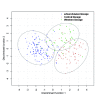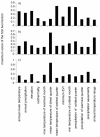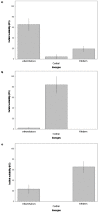Integrative analyses of speciation and divergence in Psammodromus hispanicus (Squamata: Lacertidae)
- PMID: 22129245
- PMCID: PMC3293786
- DOI: 10.1186/1471-2148-11-347
Integrative analyses of speciation and divergence in Psammodromus hispanicus (Squamata: Lacertidae)
Abstract
Background: Genetic, phenotypic and ecological divergence within a lineage is the result of past and ongoing evolutionary processes, which lead ultimately to diversification and speciation. Integrative analyses allow linking diversification to geological, climatic, and ecological events, and thus disentangling the relative importance of different evolutionary drivers in generating and maintaining current species richness.
Results: Here, we use phylogenetic, phenotypic, geographic, and environmental data to investigate diversification in the Spanish sand racer (Psammodromus hispanicus). Phylogenetic, molecular clock dating, and phenotypic analyses show that P. hispanicus consists of three lineages. One lineage from Western Spain diverged 8.3 (2.9-14.7) Mya from the ancestor of Psammodromus hispanicus edwardsianus and P. hispanicus hispanicus Central lineage. The latter diverged 4.8 (1.5-8.7) Mya. Molecular clock dating, together with population genetic analyses, indicate that the three lineages experienced northward range expansions from southern Iberian refugia during Pleistocene glacial periods. Ecological niche modelling shows that suitable habitat of the Western lineage and P. h. edwardsianus overlap over vast areas, but that a barrier may hinder dispersal and genetic mixing of populations of both lineages. P. h. hispanicus Central lineage inhabits an ecological niche that overlaps marginally with the other two lineages.
Conclusions: Our results provide evidence for divergence in allopatry and niche conservatism between the Western lineage and the ancestor of P. h. edwardsianus and P. h. hispanicus Central lineage, whereas they suggest that niche divergence is involved in the origin of the latter two lineages. Both processes were temporally separated and may be responsible for the here documented genetic and phenotypic diversity of P. hispanicus. The temporal pattern is in line with those proposed for other animal lineages. It suggests that geographic isolation and vicariance played an important role in the early diversification of the group, and that lineage diversification was further amplified through ecological divergence.
Figures









Similar articles
-
Diversification in North American arid lands: niche conservatism, divergence and expansion of habitat explain speciation in the genus Ephedra.Mol Phylogenet Evol. 2012 Nov;65(2):437-50. doi: 10.1016/j.ympev.2012.06.025. Epub 2012 Jul 7. Mol Phylogenet Evol. 2012. PMID: 22776548
-
Molecular evidence for ten species and Oligo-Miocene vicariance within a nominal Australian gecko species (Crenadactylus ocellatus, Diplodactylidae).BMC Evol Biol. 2010 Dec 15;10:386. doi: 10.1186/1471-2148-10-386. BMC Evol Biol. 2010. PMID: 21156080 Free PMC article.
-
Lineage diversification and niche evolution in the Reeves' Butterfly Lizard Leiolepis reevesii (Agamidae).Integr Zool. 2021 May;16(3):404-419. doi: 10.1111/1749-4877.12506. Epub 2020 Dec 21. Integr Zool. 2021. PMID: 33274597
-
Anthropogenic Change and the Process of Speciation.Cold Spring Harb Perspect Biol. 2023 Dec 1;15(12):a041455. doi: 10.1101/cshperspect.a041455. Cold Spring Harb Perspect Biol. 2023. PMID: 37788888 Review.
-
Ecological opportunity and the adaptive diversification of lineages.Ecol Evol. 2015 Jan;5(1):176-95. doi: 10.1002/ece3.1347. Epub 2014 Dec 17. Ecol Evol. 2015. PMID: 25628875 Free PMC article. Review.
Cited by
-
Niche models at inter- and intraspecific levels reveal hierarchical niche differentiation in midwife toads.Sci Rep. 2020 Jul 2;10(1):10942. doi: 10.1038/s41598-020-67992-6. Sci Rep. 2020. PMID: 32616878 Free PMC article.
-
Causes and evolutionary consequences of population subdivision of an Iberian mountain lizard, Iberolacerta monticola.PLoS One. 2013 Jun 7;8(6):e66034. doi: 10.1371/journal.pone.0066034. Print 2013. PLoS One. 2013. PMID: 23762459 Free PMC article.
-
Geographical and temporal body size variation in a reptile: roles of sex, ecology, phylogeny and ecology structured in phylogeny.PLoS One. 2014 Aug 4;9(8):e104026. doi: 10.1371/journal.pone.0104026. eCollection 2014. PLoS One. 2014. PMID: 25090025 Free PMC article.
-
Niche diversification of Mediterranean and southwestern Asian tortoises.PeerJ. 2022 Jul 11;10:e13702. doi: 10.7717/peerj.13702. eCollection 2022. PeerJ. 2022. PMID: 35846890 Free PMC article.
-
Multilocus phylogeography of the common lizard Zootoca vivipara at the Ibero-Pyrenean suture zone reveals lowland barriers and high-elevation introgression.BMC Evol Biol. 2013 Sep 10;13:192. doi: 10.1186/1471-2148-13-192. BMC Evol Biol. 2013. PMID: 24021154 Free PMC article.
References
-
- Losos JB. Integrative approaches to evolutionary ecology - Anolis lizards as model systems. Annu Rev Ecol Syst. 1994;25:467–493. doi: 10.1146/annurev.es.25.110194.002343. - DOI
-
- Wiens JJ, Graham CH. Niche conservatism: Integrating evolution, ecology, and conservation biology. Annu Rev Ecol Evol Syst. 2005;36:519–539. doi: 10.1146/annurev.ecolsys.36.102803.095431. - DOI
-
- McCormack JE, Zellmer AJ, Knowles LL. Does niche divergence accompany allopatric divergence in Aphelocoma jays as predicted under ecological speciation?: Insights from tests with niche models. Evolution. 2010;64:1231–1244. - PubMed
-
- Pease KM, Freedman AH, Pollinger JP, McCormack JE, Buermann W, Rodzen J, Banks J, Meredith E, Bleich VC, Schaefer RJ. et al.Landscape genetics of California mule deer (Odocoileus hemionus): the roles of ecological and historical factors in generating differentiation. Mol Ecol. 2009;18(9):1848–1862. doi: 10.1111/j.1365-294X.2009.04112.x. - DOI - PubMed
-
- Mayr E. Systematics and the Origin of Species from the Viewpoint of a Zoologist. New York: Columbia University Press; 1942.
Publication types
MeSH terms
Substances
LinkOut - more resources
Full Text Sources
Miscellaneous

